Introduction to Student Well-Being
Student well-being refers to a student’s ability to stay motivated, engaged, and mentally and physically healthy while navigating the demands of academic life. It is not just about being healthy and feeling well; it is about sustaining performance, protecting mental health, and continuing to develop in the face of academic and personal challenges.
At the core of student well-being is the ability to understand and manage the dynamic interaction between study demands (e.g., tight deadlines, high workload, and cognitive strain) and study resources (e.g., lecturer support, constructive feedback, autonomy, and social connections). When resources are sufficient and well-matched to the demands students face, they are more likely to feel engaged, resilient, and effective in their studies. However, when demands outweigh—or are misaligned with—available resources, well-being can decline, increasing the risk of burnout, disengagement, or even actual drop out.
Effectively managing this balance is central to shaping a sustainable and positive student experience.

At StudyWell, we apply the Study Demands-Resources theory (Bakker & Mostert, 2024) developed by Prof Arnold Bakker, a Professor of Work and Organisational Psychology at Erasmus University, The Netherlands and Prof Karina Mostert, a Professor of Industrial and Organisational Psychology at the North-West University, South Africa. This theory helps us to better understand how the university environment influences student well-being.
To read more about this theory and the dynamics we investigate, read our published article below:
Study Demands–Resources theory: Understanding Student Well-Being in Higher Education
Adapted from the well-established Job Demands–Resources theory (Bakker et al., 2023; Demerouti & Bakker, 2022), the Study Demands–Resources theory identifies several key components within a student’s study environment that interact, triggering both positive and negative processes that influence student well-being and outcomes. By examining how these components interrelate, alongside related personal and contextual factors, the Study Demands–Resources theory provides a structured, evidence-based framework for understanding the drivers of student burnout, engagement, health, and academic outcomes. In the next section, we provide an overview of these components and their functions within the Study Demands–Resources theory.
Study Demands and Study Resources
The Study Demands–Resources theory identifies two core dimensions within the student experience: study demands and study resources. However, student well-being is shaped by more than just the academic experience. Study, personal, and home-related demands and resources can interact in complex ways.

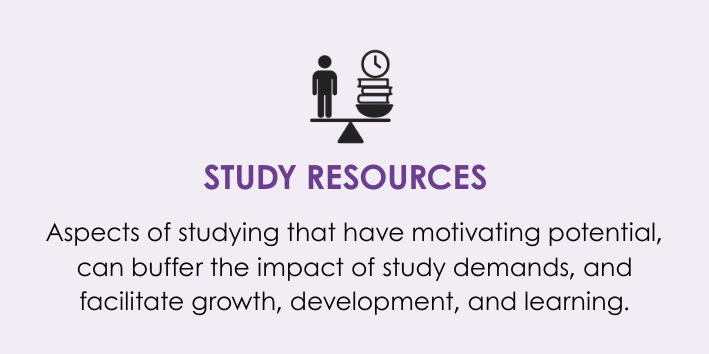
Study Demands
Study demands are the physical, psychological, social, or organisational aspects of studying that require sustained mental, emotional, or physical effort and are therefore associated with certain physiological or psychological costs. They drive the energetic process, depleting energy and potentially leading to strain or exhaustion when excessive. While some demands are considered normal and help students learn and grow, too many or too intense demands, especially without adequate resources, can leave students feeling tired, stressed, or burned out.
Examples include:
- Physical demands: Spending long hours in lectures or practical labs, sitting for extended periods of time in front of computers, and unsafe campus or living environments.
- Cognitive demands: Maintaining focus for long durations, solving complex tasks, and managing exam stress.
- Social demands: Working with diverse peers in group assignments, handling conflicts or misunderstandings, and responding to peer pressure.
- University demands: Dealing with rigid class and exam schedules, limited access to campus facilities and equipment, and keeping track of multiple deadlines and rules.
- Personal demands: Internal characteristics, tendencies, or self-imposed pressures that require sustained psychological effort and may drain energy or hinder optimal functioning (e.g., perfectionism, fear of failure).
Study Resources
Study resources are the physical, social, and organisational aspects of the study environment that help students achieve their goals, reduce study demands, and promote learning and development. They drive the motivational process, fostering engagement, well-being, and academic success. While some resources are naturally part of university life, others can be intentionally developed or accessed to strengthen students’ ability to deal with challenges and thrive academically and personally.
Examples include:
- Physical resources: Access to comfortable and equipped study spaces, textbooks, healthy food, safe campus facilities, and constructive learning environments.
- Cognitive resources: Opportunities to function autonomously, meaningful feedback from lecturers, perceived relevance of course content to personal or career goals, and goal clarity.
- Social resources: Having supportive peers, encouraging mentors and lecturers, and collaborative group dynamics.
- University resources: Well-structured class and exam schedules, accessible student services, and well-designed learning and study spaces.
- Personal resources: Psychological assets within the individual that support resilience, growth, and academic persistence, helping students cope effectively with study demands and maintain well-being (e.g., self-efficacy, optimism).
Student Behaviours
Student well-being and the overall university experience are shaped by both the university and students’ behaviours - it is a shared responsibility. While the university provides support and resources, students also have accountability for how they navigate their studies. Some students respond proactively, adapting to challenges and leveraging available resources, while others may fall into self-defeating patterns that increase strain or reduce engagement.
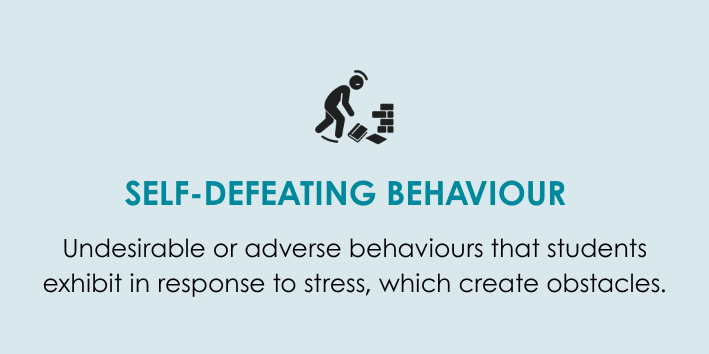

Self-defeating Behaviours
In practical terms, self-defeating behaviours refer to maladaptive patterns that hinder students’ ability to cope with demands or access available resources. They are typically reactive, short-term oriented, and may result from feelings of helplessness, overload, or exhaustion. Self-defeating behaviours can also create additional demands and undermine performance, often triggering a negative spiral.
Examples include:
- Avoidance: Skipping lectures or assignments due to anxiety or loss of motivation.
- Overextension: Taking on too much work without adequate support or capacity.
- Withdrawal: Disconnecting from friends, lecturers, or one’s studies when things get tough.
- Self-sabotage: Procrastinating, setting unrealistically high standards, or refusing help even when it's available.
Proactive Behaviours
Proactive behaviours are actions that students intentionally take to improve their learning conditions, well-being, or performance. Students who engage in such behaviours often feel more motivated and in control of challenges. Proactive behaviour enables students to generate or access resources, manage stress, and initiate positive spirals of well-being and success.
Examples include:
- Study crafting: When students proactively adjust their tasks and social relationships or align their demands and resources to enhance the meaning of their activities and to create a better fit between their skills, preferences, and the situation.
- Proactive strengths use: When students utilise their strengths (e.g., kindness, courage, creativity, analytical thinking) proactively to achieve individual, goal-oriented behaviour aimed at managing physical and mental energy, promoting optimal functioning and success.
- Deficit improvement: When students take the initiative to actively seek opportunities to address and improve areas of weakness or proactively develop skills in which they feel less confident (e.g., using planning tools to overcome procrastination; requesting mentoring or coaching to develop presentation skills).
Student Burnout and Engagement
The Study Demands–Resources theory explains student well-being through a health impairment and motivational process. The health-impairment process is triggered when a student’s demands exceed their available resources, leading to feelings of exhaustion, cynicism, and a lack of efficacy. However, when resources are available and well-aligned with their demands, students may feel more energised, motivated, and engaged, even in the face of high demands.
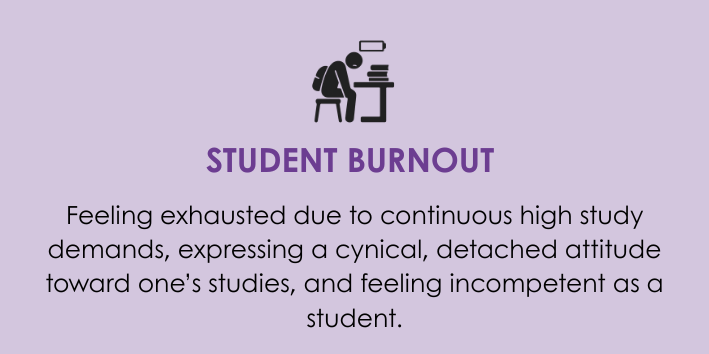
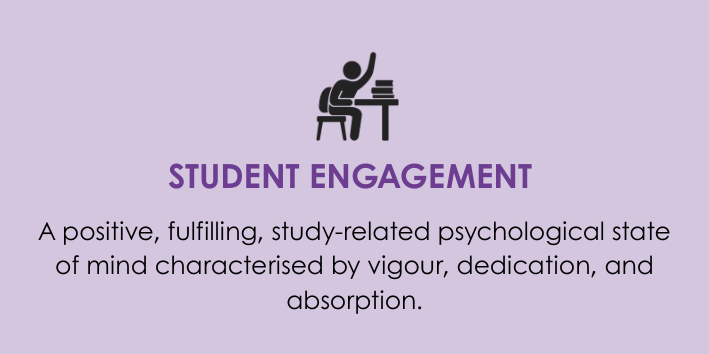
Student Burnout
Student burnout is a state of prolonged stress that develops over time when a student’s study demands continuously exceed their available resources. It typically involves three interrelated components:
- Exhaustion occurs when students experience extreme mental, emotional, or physical fatigue due to continuous or excessively high study demands over an extended period of time. Students may struggle to concentrate or wake up feeling tired despite getting enough rest.
- Cynicism is evident when students develop a negative and distant attitude towards studying, lecturers, peers, or the university. Students may start skipping lectures or feeling that their studies have little meaning.
- Reduced professional efficacy manifests when students begin to experience doubt about their study abilities, feeling incompetent or lack the confidence to meet expectations.
Burnout symptoms do not emerge overnight. Instead, they result from a continuous negative spiral in which high demands, inadequate resources, and negative self-defeating behaviours reinforce each other.
Student Engagement
Student engagement is defined as a fulfilling state of mind related to study, where a student is motivated and actively involved in their study-related tasks and environment. Student engagement consists of three dimensions, namely:
- Vigour is characterised by high levels of energy and mental resilience while studying, demonstrating a willingness to invest effort, seeking help, and persevering in the face of difficulties.
- Dedication refers to a student’s strong sense of devotion, perseverance, significance, enthusiasm, inspiration, and pride in their studies.
- Absorption occurs when students are happily immersed in study-related tasks, deeply concentrated and where it feels as if time passes quickly.
Abundant resources are the primary driver of student engagement. Engagement also occurs when demands are balanced and met by adequate and available resources. Proactive behaviours, such as seeking feedback, building supportive peer networks, and study crafting, can boost engagement and create a positive upward spiral of well-being and performance.
Student Health
Beyond burnout and engagement, other health-related aspects of a student’s life are essential, including physical, mental, and emotional health. When students cultivate habits that protect and enhance these aspects of their lives, they are better equipped to navigate the challenges and opportunities of university life and flourish as students.
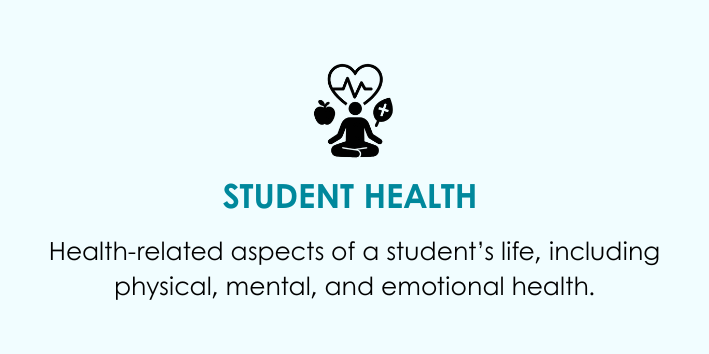
Other aspects of well-being may include:
- Physical health: Getting enough sleep, maintaining a nutritious diet, exercising regularly, and managing illness or disability.
- Mental health: Managing stress and anxiety, building coping skills, seeking help when needed, and maintaining mental resilience.
- Emotional well-being: Experiencing positive emotions, frequent experiences of happiness, and a positive interest in life.
- Flourishing: Students flourish when they pursue meaningful goals, experience personal growth, feel confident in their career journey, and are connected, supported, and contributing to the academic community.
Each dimension of student health can serve as a resource that strengthens a student’s ability to manage demands and sustain motivation, engagement, and performance over time.
Student Outcomes

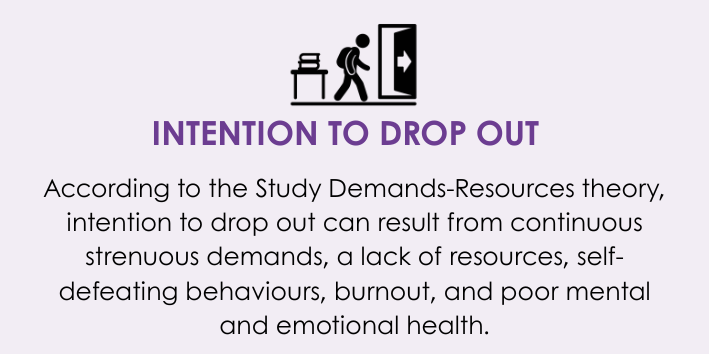
Performance
Academic performance is one of the most observable outcomes of the dynamic interplay between study demands, study resources, and student behaviours. Importantly, performance is not only about grades or completion rates, but also about the development of core academic competencies, critical thinking, and the ability to transfer learning across contexts.
When students experience a balanced and supportive academic environment (characterised by adequate study resources, effective feedback, and opportunities for autonomy), they are more likely to remain motivated, focused, and productive.
Students who perform well often demonstrate the following behaviours and traits:
- High levels of energy and motivation
- Sustained concentration and interest in academic tasks
- Persistence in the face of challenges or setbacks
- Proactive adaptation of their study environment (e.g., seeking feedback)
- Use of personal strengths (e.g., analytical thinking or collaboration)
- Willingness to develop areas in which they feel less confident
Intention to drop out
Students’ intention to discontinue their studies could be a significant indicator of compromised well-being. In line with the Study Demands–Resources theory, this intention often arises from prolonged experiences in which study demands exceed available resources. Over time, this can lead to the health-impairment process, in which the student begins to feel emotionally and physically exhausted, disconnected from their studies, and uncertain about their academic abilities.
Students who are considering dropping out of university frequently could show the following traits:
- Unmanageable demands and insufficient resources to sustain their studies
- Persistent fatigue and difficulty recovering energy
- A loss of interest or meaning in their studies
- Feelings of inefficacy or low academic self-confidence
- Avoidance of academic tasks or learning environments
- Withdrawal from academic or social support networks
- A growing sense that their efforts are not leading to progress or recognition
If these signs are not addressed, they may contribute to further disengagement and ultimately lead to the decision to leave the university. However, the intention to drop out is not irreversible. Early identification of these warning signs and timely access to appropriate support can help restore balance between demands and resources, enabling students to re-engage with their studies and continue their academic journey.
The key components listed above form the foundation of the StudyWell initiative’s tools, interventions, and monitoring systems. Whether you are a student navigating university life, a staff member supporting students, or part of institutional management designing student systems, understanding these dynamics is critical to fostering sustainable well-being, academic performance, and personal development.
To explore how the same theoretical principles apply beyond the student context, read the articles below. They offer valuable insights into how the Job Demands–Resources theory (Bakker et al., 2023; Demerouti & Bakker, 2022) has been applied across occupational settings and may provide further context for understanding student well-being through a broader lifespan development lens.
Job Demands–Resources theory In Times Of Crises: New Propositions
Job Demands–Resources theory: Ten Years Later
